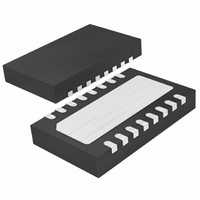LTC4218CDHC-12#PBF Linear Technology, LTC4218CDHC-12#PBF Datasheet - Page 10

LTC4218CDHC-12#PBF
Manufacturer Part Number
LTC4218CDHC-12#PBF
Description
IC CTLR HOT SWAP 16-DFN
Manufacturer
Linear Technology
Type
Hot-Swap Controllerr
Datasheet
1.LTC4218CDHC-12PBF.pdf
(18 pages)
Specifications of LTC4218CDHC-12#PBF
Applications
ATCA, MicroTCA™
Internal Switch(s)
No
Voltage - Supply
2.9 V ~ 26.5 V
Operating Temperature
0°C ~ 70°C
Mounting Type
Surface Mount
Package / Case
16-WFDFN Exposed Pad
Lead Free Status / RoHS Status
Lead free / RoHS Compliant
Available stocks
Company
Part Number
Manufacturer
Quantity
Price
APPLICATIONS INFORMATION
LTC4218
The typical LTC4218 application is in a high availability
system that uses a positive voltage supply to distribute
power to individual cards. The basic application circuit
is shown in Figure 1. External component selection is
discussed in detail in the following sections.
Turn-On Sequence
The power supply on a board is controlled by placing
an external N-channel pass transistor (Q1) in the power
path. Note the sense resistor (R
the capacitor (C
prevents high frequency oscillations in Q1 and resistor
R
Several conditions must be present before the external
pass transistor can be turned on. First, the supply V
must exceed its undervoltage lockout level. Next, the
internally generated supply INTV
undervoltage threshold. This generates a 25μs power-
on-reset pulse which clears the logic’s fault register and
initializes internal latches.
After the power-on-reset pulse, the LTC4218 will go through
the following sequence. First, the UV and OV pins must
indicate that the input power is within the acceptable range.
All of these conditions must be satisfi ed for a duration
of 100ms to ensure that any contact bounce during the
insertion has ended.
10
12V
GATE
isolates C
Figure 1. 3A, 12V Card Resident Application
0.1μF
C
GATE
224k
T
GATE
20k
R2
R3
0.1μF
) controls gate slew rate. Resistor R1
C1
during fast turn-off.
R4
140k
R5
20k
2mΩ
R
S
SENSE
SENSE
V
UV
FLT
OV
TIMER
INTV
DD
CC
LTC4218GN
–
+
Si7108DN
GATE SOURCE
GND
Q1
CC
R1
10Ω
S
) detects current and
must cross its 2.65V
I
MON
I
SET
PG
FB
12V
R
1k
R8
10k
R
20k
R
20k
GATE
SET
MON
C
0.01μF
GATE
150k
20k
R6
R7
+
ADC
C
330μF
V
12V
3A
L
4218 F01
OUT
DD
The pass transistor is turned on by charging up the GATE
with a 24μA charge pump generated current source
(Figure 2).
The voltage at the GATE pin rises with a slope equal to
24μA/C
When the GATE voltage reaches the MOSFET threshold
voltage, the switch begins to turn on and the SOURCE
voltage follows the GATE voltage as it increases. Once
SOURCE reaches V
by the 6.15V zener between GATE and SOURCE.
As the SOURCE pin voltage rises, so will the FB pin which
is monitoring it. If the voltage across the current sense
resistor (R
by the internal current limiting circuitry. Once the FB pin
crosses its 1.235V threshold and the GATE to SOURCE
voltage exceeds 4.2V, the PG pin will cease to pull low and
indicate that the power is good.
Turn-Off Sequence
The switch can be turned off by a variety of conditions. A
normal turn-off is initiated by the UV pin going below its
1.235V threshold. Additionally, several fault conditions will
turn off the switch. These include an input overvoltage (OV
pin) and overcurrent circuit breaker (SENSE pin). Normally,
the switch is turned off with a 250μA current pulling down
the GATE pin to ground. With the switch turned off, the
SOURCE pin voltage drops which pulls the FB pin below
its threshold. The PG then pulls low to indicate output
power is no longer good.
I
INRUSH
V
DD
GATE
+ 6.15
V
S
DD
=
) gets too high, the inrush current will be limited
and the supply inrush current is set at:
C
GATE
C
L
Figure 2. Supply Turn-On
DD
• 24µA
SLOPE = 24μA/C
, the GATE will ramp up until clamped
GATE
t1
t2
4218 F02
GATE
SOURCE
4218fe














